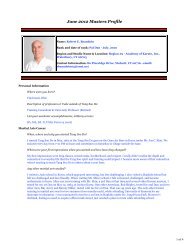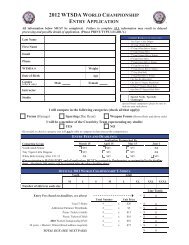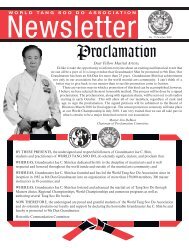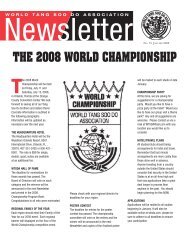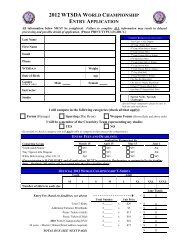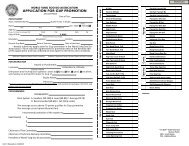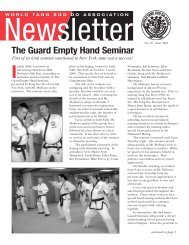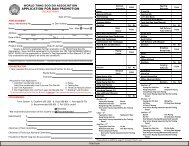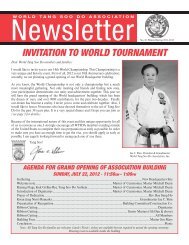Masters of Perseverence - The World Tang Soo Do Association
Masters of Perseverence - The World Tang Soo Do Association
Masters of Perseverence - The World Tang Soo Do Association
- No tags were found...
You also want an ePaper? Increase the reach of your titles
YUMPU automatically turns print PDFs into web optimized ePapers that Google loves.
SMART TRAINING - Training to come back another dayAs martial artists, we aretrained to analyze oursurroundings and to look forpossible threats and hazardswithin our environment. For obviousreasons, we avoid situations in societywhere trouble can occur.For example, if I had to travelalone after dark, I would choose aroute that is well lit and in observation<strong>of</strong> others instead <strong>of</strong> taking a short cutthrough a darkened, secluded alley.Even though we are learning selfdefense,we should not directly seekout trouble to test our abilities.While working on a constructionjob this past August, I dislocated myright shoulder. In October, just as itbegan to feel “normal” again, Idislocated my left shoulder moresituations. If you practice yourtechniques poorly, they will beexecuted in the same manner as youpracticed them. While I took a fewdays <strong>of</strong>f from class to recover from one<strong>of</strong> the injuries, I thought about this. IfI had to defend myself in my currentcondition, what would I do?With only one semi-good arm,how am I going to practice in classexactly like I would fight if my lifedepended on it? This became aturning point concerning my attitudetowards training with my injuries.While training during the course<strong>of</strong> recovery, I had to learn mylimitations from how I participate indrill, practicing with a partner, basictechniques and free sparring. I beganto use my shoulders to my advantagereferring to bettering my trainingI do not feel that my shoulders haveyet to fully heal.Honestly, I don’t think that theywill ever be back to one hundredpercent. I consider it an <strong>of</strong>f again, onagain injury. <strong>The</strong>re is one thing that Inoticed about myself during the <strong>of</strong>fand pain-free times: I will catch myselfdoing a lot <strong>of</strong> activity in class usingonly one arm regardless <strong>of</strong> the status<strong>of</strong> my shoulder.<strong>The</strong> other day in class we werepracticing break falling. I came up tothe mat and paused like a kid who wasabout to jump <strong>of</strong>f the high dive for thevery first time. I stood there for amoment not sure if I was scared, but Idefinitely hesitated.I believe the instructor could alsotell my weariness. My shoulders wereSelf-defense can be defined as the means necessary to keep yourself safe. Itnot only applies to your actions <strong>of</strong> protecting yourself on the street, but it alsoapplies to what you need to do in class to protect yourself so you can comeseverely. I am speculating that myright shoulder began to compensatefor the left and started to act-up again.As a result, I had two hurtingshoulders.With having back-to-back separateshoulder injuries, I became a littledepressed at the thought <strong>of</strong> mytraining being done for a while, yet Isomehow got through testing andpromotions. I did not miss as manyclasses as I expected.Over the next several months, Ilearned how to adapt my injury to my<strong>Tang</strong> <strong>Soo</strong> <strong>Do</strong> training. I truly thoughtthat class for me was going to beboring. This is not something that Iwas used to since I am accustomed totraining hard and to the best <strong>of</strong> mycapabilities.In class, we are introduced tophilosophies regarding our attitudesand how it directly relates to ouractions “on the street” in self-defenseroutine. In my opinion, in some ways,being injured enhanced my <strong>Tang</strong> <strong>Soo</strong><strong>Do</strong>.As one medical pr<strong>of</strong>essional putit: “if you lost your vision, yourhearing would become better.” I waslearning material that is usuallypreformed with two hands, and I wasexperimenting how to do it with onlyone. It was discouraging at first whenthings did not work, but I wouldrather it not work in class than for meto try it and it not work when I reallyneeded it to defend myself.As time went on my shouldersbecame stronger and I was becomingmore adept with everyday routinesusing my shoulders and arms.Simple things, such as, openingand closing the car door, shifting fromsecond to third gear, or simplysleeping, no longer became a burdenor painful experience. Although I amcapable <strong>of</strong> performing these functions,bothering me from something that Idid in class earlier, and a little voicetold me not to make that forwardbreak fall. I bowed to the instructorrequesting that I observe instead <strong>of</strong>participating.For a minute, I may have feltembarrassed for bowing out andappearing to have “chickened out,”but that subsided after class when myhead instructor said that was smarttraining.Self-defense can be defined as themeans necessary to keep yourself safe.It not only applies to your actions <strong>of</strong>protecting yourself on the street, but italso applies to what you need to do inclass to protect yourself so you cancome back and train another day.Submitted by:Dave Ilko, Cho DanRiver Valley <strong>Tang</strong> So <strong>Do</strong> AcademyAliquippa, PAJanuary 2007 WTSDA News 7



